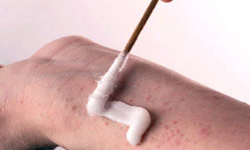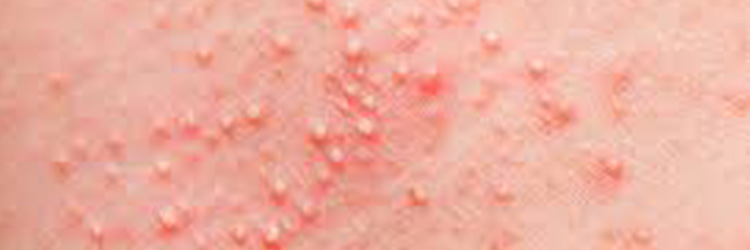Have you ever shaved or waxed your arms or legs, and noticed a red pimple later, with hair growing out of it? What you have is folliculitis. Folliculitis is a common skin condition where the hair follicle gets inflamed and is usually caused by:
- Bacterial, fungal or viral infections
- Physical injury
- Environmental or chemical irritants
At first glance, the condition may look like small bumps or white-headed pimples – this is because when a follicle gets inflamed, it forms a painful red spot with an overlying pustule and a central hair growing out of it. It is usually accompanied by itching or soreness around the affected area, eventually resembling acne pimples or crusty sores.
Inflamed Hair Follicles
A follicle is a tiny pocket from which hair grows. Follicles are densest on your scalp and can occur everywhere on your body barring your lips, mucous membranes, the soles of your feet, and your palms. When a hair follicle gets damaged, it runs the risk of infection. Here are a few common causes of follicle damage:
- Heat and excessive sweating
- Friction from shaving/razors on the skin
- Friction from tight clothing
- Skin conditions like dermatitis and acne
- Skin injuries from cuts, scrapes, or surgical wounds.
- Coverings on your skin, such as plastic dressings or adhesive tape
What Causes Folliculitis?

- Bacteria: The most common type of bacteria to infect the hair follicle is the staph bacteria, which live on your skin all the time. The infection flares up when staph bacteria enter your body through a cut or other wound. Pseudomonas bacteria can cause a different strain of folliculitis called hot-tub folliculitis since this bacteria is found in hot tubs and heated pools where chlorine and pH levels aren’t well-regulated.
- Fungi: Tinea capitis or ringworm of the scalp is a fungal infection that affects hair on the scalp. It often presents itself as hair loss and scaling, but can cause severe inflammation in some people.
- Yeast: Pityrosporum folliculitis is caused by a yeast called Pityrosporum ovale and shows up as an itchy acne-like rash on the back and chest of young adults.
- Virus: The herpes simplex virus or cold sore virus can cause folliculitis in men who use razors and experience recurring bouts of facial herpes.
- Environmental factors: There are a host of environmental factors that cause folliculitis.
- The major ones are razors and ingrown hairs.
- Mechanical folliculitis is caused by frequent shaving against the direction of the hair follicle, or by wearing tight clothes.
- Occlusion folliculitis occurs when the follicle opening is blocked by exposure to topical products like creams, gels, lotions, ointments, and grease. This blockage results in inflammation of the follicle.
- Chemical folliculitis is caused when the skin or follicle is exposed to substances like coal tars, or due to the overuse of topical medications such as corticosteroids. This leads to swelling and obstruction of the follicular opening.
Folliculitis Treatment:
Whether it is on the arms, the legs, or scalp folliculitis treatment, the course depends on the type and severity of the condition and can range from pill to topical medications to laser hair removal to even surgery, in severe cases. While the condition isn’t life-threatening; it can be irritating because it causes itching, and soreness, and can be embarrassing due to its appearance.
In general, mild cases tend to clear within a day or two with simple self-care measures. For severe and recurring cases of folliculitis, you need to see a doctor.
Simple measures to treat folliculitis include:
- Minimising heat, sweating, and friction in the area
- Wearing loose clothing made of cotton or natural fibers
- Cleaning and protecting the affected skin area. Wash with antibacterial soap + a clean washcloth, avoiding shaving + razors.
- Applying a warm, moist washcloth or compress.
- Using oil-free topical products.
Medicated treatments include:
- Antibiotic creams, lotions, gels, or pills to control the infection
- Antifungal creams, shampoos, or pills to combat fungal infections
- Steroid creams to ease itching and inflammation
- Surgery: If you have a large boil or a carbuncle, your doctor may have to drain it by making a small incision on the surface of the skin. Draining the pus will relieve pain, speed up your recovery, and can reduce scarring. The affected area is covered with gauze while the pus continues to drain.
- Laser hair removal : This is a course of action of all other treatments fail since long-term/permanent hair removal can clear up the infection for good. Since the follicle itself is removed, the density of hair in the affected area is greatly reduced. This is, however, a costly procedure with possible side effects that include scarring and blistering.
When it comes to scalp folliculitis treatment, the follicles are generally infected with the bacteria Staphylococcus. White, itchy pustules or pimples form around the follicles on the scalp and eventually crust over, with white goo or pus beneath it. If the infection is deeper, boils or carbuncles may erupt. The course of treatment remains the same – medicated treatments ranging from creams to pills, and draining the carbuncle in more severe cases.
If you are suffering from any of the above symptoms, get in touch with a medical professional. Find a qualified dermatologist near you on dermatologist near you.














